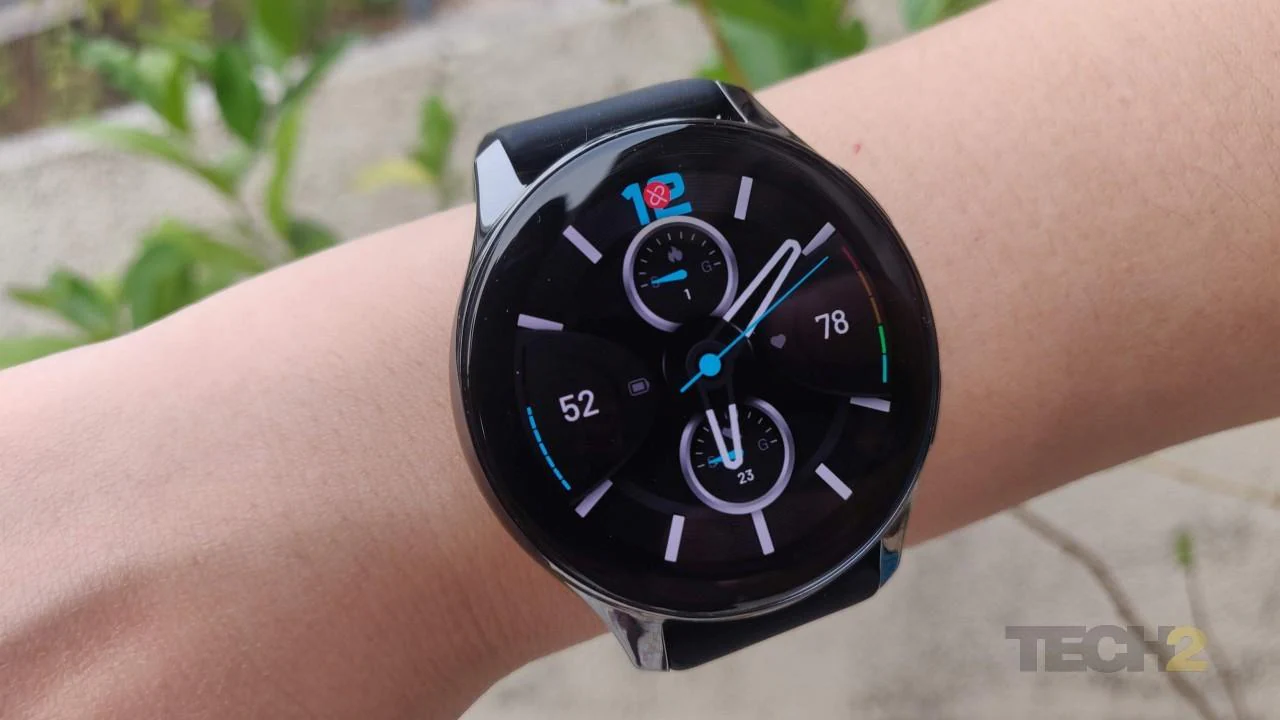Ameya DalviMay 17, 2021 11:33:29 IST
Rating: 3.8/5
Price: Rs 14,999
The sub-Rs 15,000 segment of fitness watches in India is quite crowded, with the likes of Amazfit, Xiaomi, Realme and others setting the bar fairly high. They offer an impressive feature set and performance for the budget, and OnePlus now looks to take them on with their latest product. After a lacklustre debut in the entry-level wearables realm with their fitness band, the company is now targeting a higher bracket where ‒ logically ‒ it should be more comfortable plying its trade. Say hello to the OnePlus Watch. Yes, that’s what it’s called.

OnePlus Watch. Image: Tech2/Ameya Dalvi
Like most OnePlus products in recent times, it was a little undercooked at launch (we are being charitable). But after a recent firmware update, a lot of issues have been addressed, if not all. The review would have read a lot differently, had I published it last month, but this is how things stand at the moment. So let’s take a look at what’s good about it and what’s not in this long-term review after a month of use.
What’s good about the OnePlus Watch
Sturdy build, neat design
While it won’t win any design innovation awards, the OnePlus Watch does look quite smart draped in all black, especially the “Midnight Black” edition. The 46 mm round dial blends seamlessly into the stainless steel body, and the only branding present is on one of the buttons on the right side; it took me a couple of days to spot it. There are no rough edges on the watch and the construction is sturdy enough to survive a few bumps.
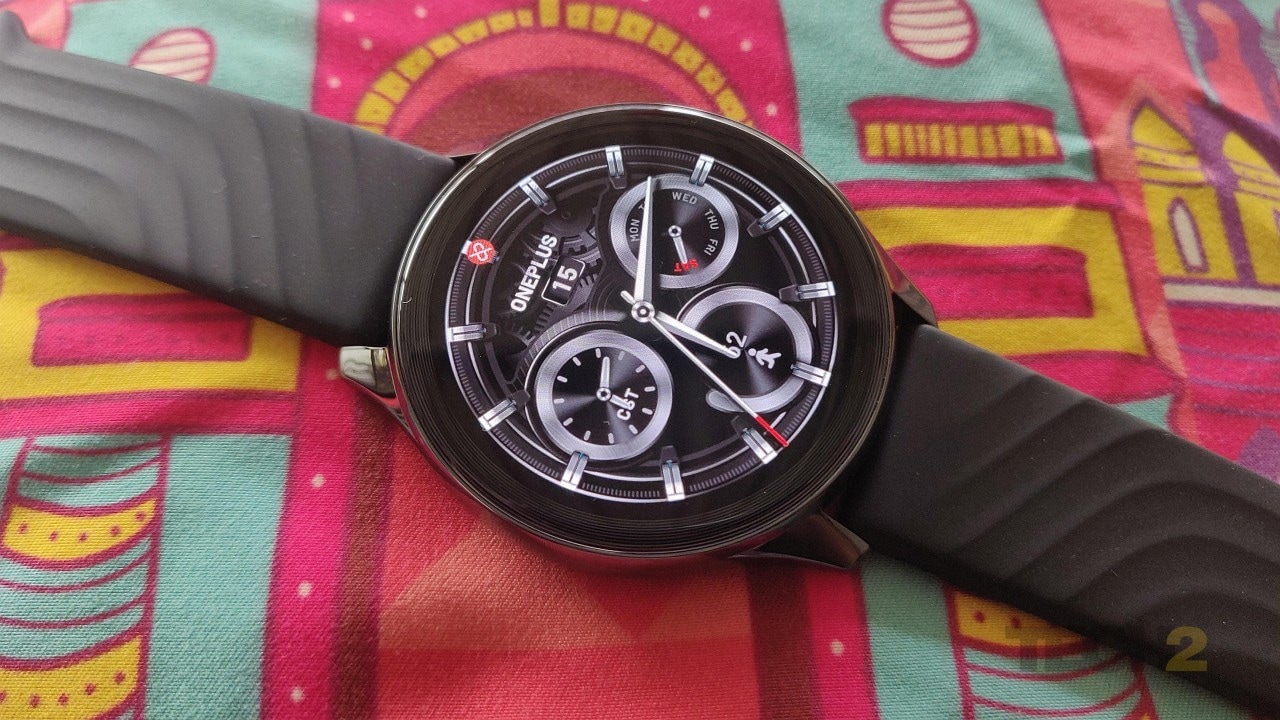
It is a little heavy at around 76 grams with the strap, which is about 15 grams heavier than the competition. Image: Tech2/Ameya Dalvi
This watch is relatively large, and if you have slim wrists, it may look bigger than is ideal. If you are fine with that, no problem. It is also a little heavy at around 76 grams with the strap, which is about 15 grams heavier than the competition. The straps have the standard 22 mm width, meaning you can use any 22 mm strap with this watch. And you may need to do that sooner than later, if the bundled strap is not a good fit for you. More on that later.
Sharp display, now with always-on
The display is quite impressive. You get a sharp 1.39-inch AMOLED touchscreen with a resolution of 454 x 454 pixels (326 ppi pixel density). It is protected against scratches by a layer of sapphire glass that seems to do its job well, as there was not a single scratch on the screen after using the watch for a month. There also seems to be some oleophobic coating present, as I could barely notice any fingerprints or smudges on the display. You get five levels of brightness to choose from, or you can just set it on auto mode. Level 3 did the job for me indoors, and the screen is perfectly legible in bright outdoors at level 4.
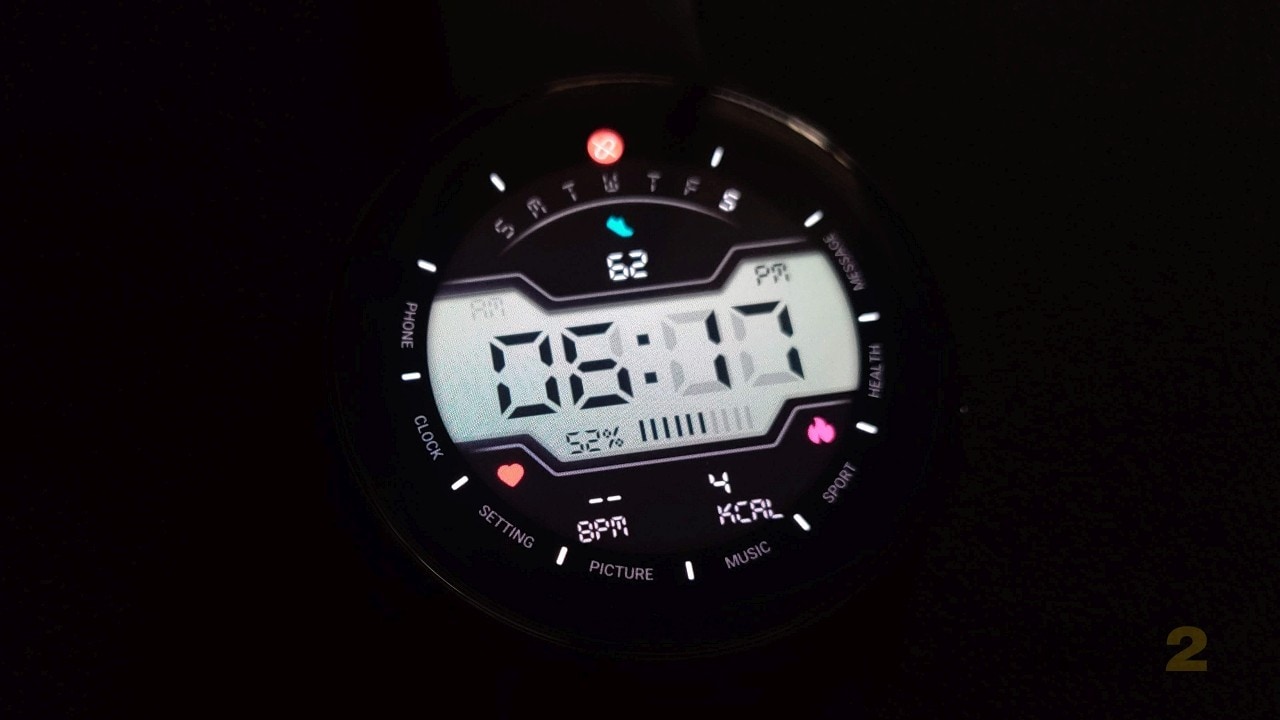
You get five levels of brightness to choose from, or you can just set it on auto mode. Image: Tech2/Ameya Dalvi
The OnePlus Watch now supports always-on display, after a recent firmware update (the feature was missing at launch), but it comes with a warning that it may consume 50 percent of the battery. That’s too much to sacrifice just to see the time and date flashing there. Best to turn it off and flick your wrist to check it; don’t be lazy. Though it’s generally responsive, I would have preferred the flick response to be a bit more sensitive; I often had to flick my wrist twice to wake the screen. Enabling sleep mode from the pull-down menu disables the flick-to-wake feature; quite useful when going to sleep or in a dark environment like a theatre.
Finally, some nice watch-faces after the recent update
This point was firmly placed in the cons in the first iteration of my review. There were just 15 watch-faces at launch, and each more boring than the previous. Thankfully, you now have a few dozen faces and much better looking ones too; one can expect more in the future. You get a decent mix of analogue and digital options to choose from. What’s even better is that you can store up to 14 faces on the watch itself, once you transfer them from the app. The download and transfer process is noticeably faster than the competition.
The pulse oximeter is fairly brisk and non-fussy
The SpO2 sensor on the watch that measures the level of oxygen saturation in the blood is fairly brisk for the segment. Though not as quick as a dedicated oximeter, you get a reading in about 20 seconds if you keep your hand steady; the competition takes about 10 to 15 seconds longer. It isn’t as fussy as some other watches that refuse to give you a reading if the watch screen isn’t facing skywards. The results were comparable to a basic over-the-counter oximeter, but it’s best to take a couple of readings to be doubly sure. As always, this feature serves as a broad guideline and is not meant to replace clinical instruments.
Limited, but useful fitness features
The OnePlus Watch has a wide array of sensors to track your fitness and workouts. Other than the aforementioned SpO2 sensor, it also has an optical heart rate monitor, accelerometer, gyroscope, geomagnetic sensor and sensors for ambient light, air pressure and capacitance. This watch has 15 main fitness modes that cover common fitness activities such as walking, running, cycling, swimming, yoga, freestyle and sports such as cricket and badminton. You have indoor modes for running, cycling and rowing. The watch has an IP68 ingress rating and is 5ATM water resistant, and hence can be taken along for a swim.
The watch often detects certain outdoor workouts automatically and prompts you to start them for better tracking. When outdoors, the results are fairly accurate with a 2 percent margin of error at most, which is acceptable in this segment. Indoor tracking is a bit of a hit or miss, especially the steps counter, which is on the conservative side. The watch also tracks your sleep patterns and gives you a breakdown on the watch screen itself that includes the quantum of deep sleep, light sleep and awake time. There is no REM data available even in the app. Also, the watch only shows you the synopsis of the previous night’s sleep data. If you need more details about current and previous sleep patterns, you can find those in the OnePlus Health app, along with your blood oxygen level while you are asleep.
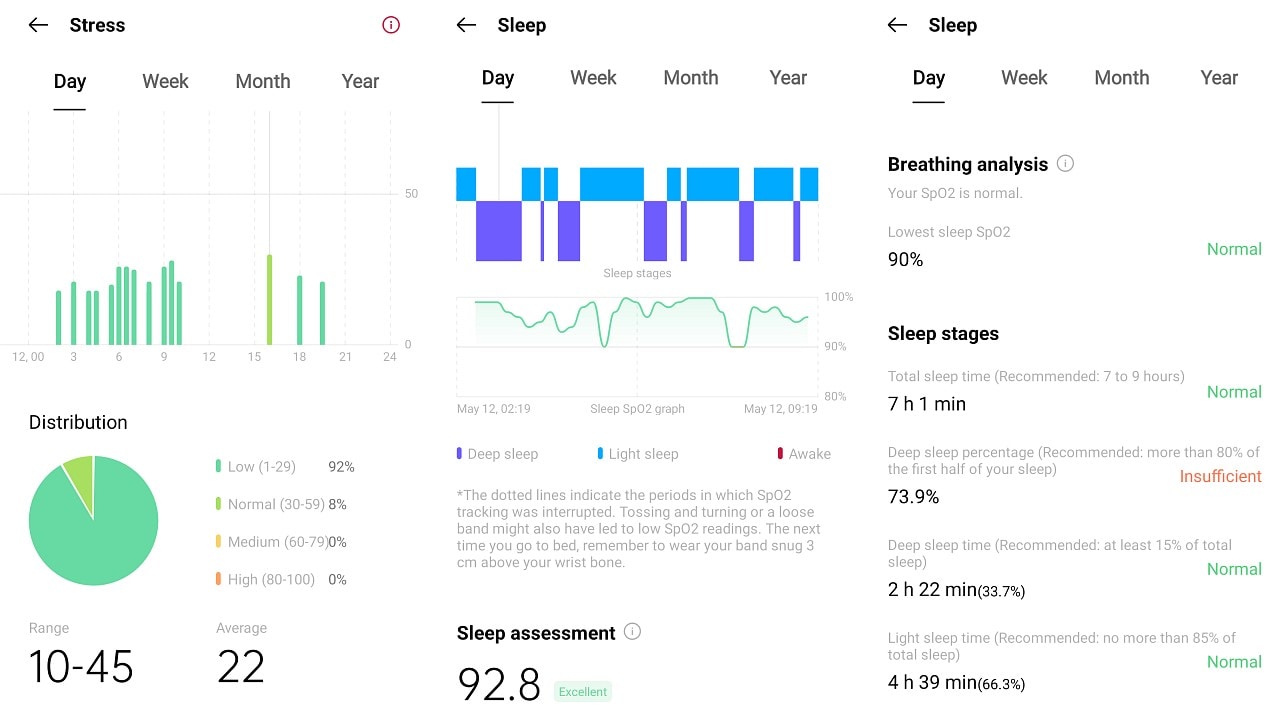
The watch gives you a breakdown on the watch screen itself that includes the quantum of deep sleep, light sleep and awake time. Image: Tech2/Ameya Dalvi
In addition, you also get stress measurements based on the frequency of variations in your heart rate. Speaking of heart rate, the sensor frequency can be set to either continuous or smart from the app; I prefer the former as I found the latter quite unlike its name. Yes, it does impact the battery, but not as much as the ambient display. Also, the fitness tracking is more accurate that way, which is the very essence of such products. You get to store and play music from the watch directly, without needing a phone. You get about 2 GB space for this. The watch is Bluetooth 5.0 compliant and you can use wireless earphones with it.
Place calls directly from the watch
Like most fitness trackers, the smart features are limited to app notifications, messages and call alerts. However, the OnePlus Watch goes a step or two further, and not just lets you answer or reject calls, but also lets you make a call from the watch itself. You can import a few contacts and there’s also a dialer here. The watch also has a microphone and a speaker and you can have a conversation right from the watch itself, without having to go looking for the phone. The call quality is passable. Best to use a bluetooth headset rather than using the watch like one.
Easy to use and stutter-free performance
The watch UI is fairly simple. Swipe down for quick settings, swipe up for messages and notifications and swipe left to access the music player, heart rate data and sleep info. I wish there were more options here or a choice to decide what goes here from the app, but not yet. The top button can be used to wake up the screen or head to the app drawer. You can press it to go back to the home screen too from anywhere in the UI. The bottom button serves as a shortcut for fitness modes from the homescreen. The UI is snappy and mostly lag-free. Since this watch doesn’t run a smart OS like Wear OS, you do not get an option to install any additional apps, which is also the case with most of its competitors in this price range.
Good battery life
The OnePlus Watch claims a 14-day battery life under test conditions, but in reality you get anything between a week to ten days depending on your usage. With ambient display off, flick wrist to wake screen enabled, screen brightness set to 3, a few notifications enabled, one hour of fitness activity daily, heart rate monitoring set to continuous, half a dozen Oximeter readings in a day and 3 nights of sleep tracking with oxygen readings, I managed to get little over a week out of the watch. That’s good battery life, though not the highest in the segment.
What needs to improve in the OnePlus Watch
One strap doesn’t fit all
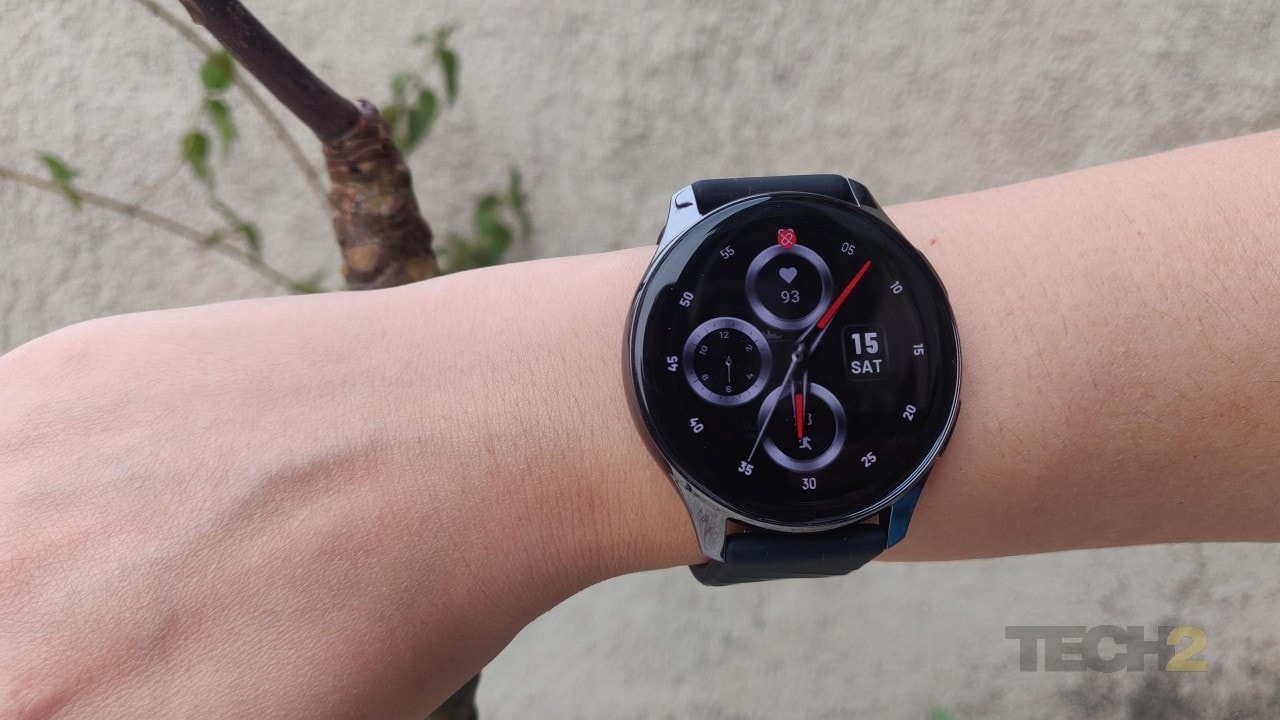
The company could have at least provided a choice between medium and large straps, if not include both. Image: Tech2/Ameya Dalvi
OnePlus bundles one strap (preinstalled) with this watch, and it’s quite large for people with slimmer wrists. Yes, you can easily replace the strap but you wouldn’t want to do that on day one, would you? The company could have at least provided a choice between medium and large straps, if not include both. Getting the right fit around your wrist is of paramount importance for fitness watches, for accurate tracking. The Apple watch style lock-in mechanism offered here isn’t my favourite either, nor the most secure.
Steps counter struggles to register steps indoors
When outdoors, with the GPS locked in, the steps count is fairly accurate. But indoors where there is no GPS signal, the steps counter is overly conservative. At times, it doesn’t register movement at all, and asks you to get up and move even if you have been active for the past ten minutes. The watch does not have an indoor walk option either. This is something for OnePlus to look into and fix in the next update. One good characteristic is that the watch does not register false steps even if you throw your hands around to fool it.
Certain UI elements and smart features could have been smarter
While this isn’t a full-fledged smart watch, there are certain elements that could have been better. On top of that list is notifications management. They are all listed one after the other on the watch screen; grouping them smartly would have been nicer. Also, swiping them away from either the watch or the phone doesn’t have any effect on the other device. You have to open or dismiss them from both devices; this definitely needs to change. Reply options are half-baked too. Also, tapping the screen doesn’t wake it up; you have to flick your wrist or press a button to do that. Not cool!
While the phone UI is generally easy to use, it could have been a lot smarter. For instance, one of the four screens when you swipe left is dedicated to sleep data. How often are you going to check that during the day? Having one for either activity progress or stress data would have been more useful. Or simply let the user choose what they want to see there from that app, but that’s not an option currently. Similarly, I would like to see more customisable watch-faces where the user can choose the fitness information to be displayed there rather than just colour options. Right now, there are very few that allow that.
Companion app needs to improve
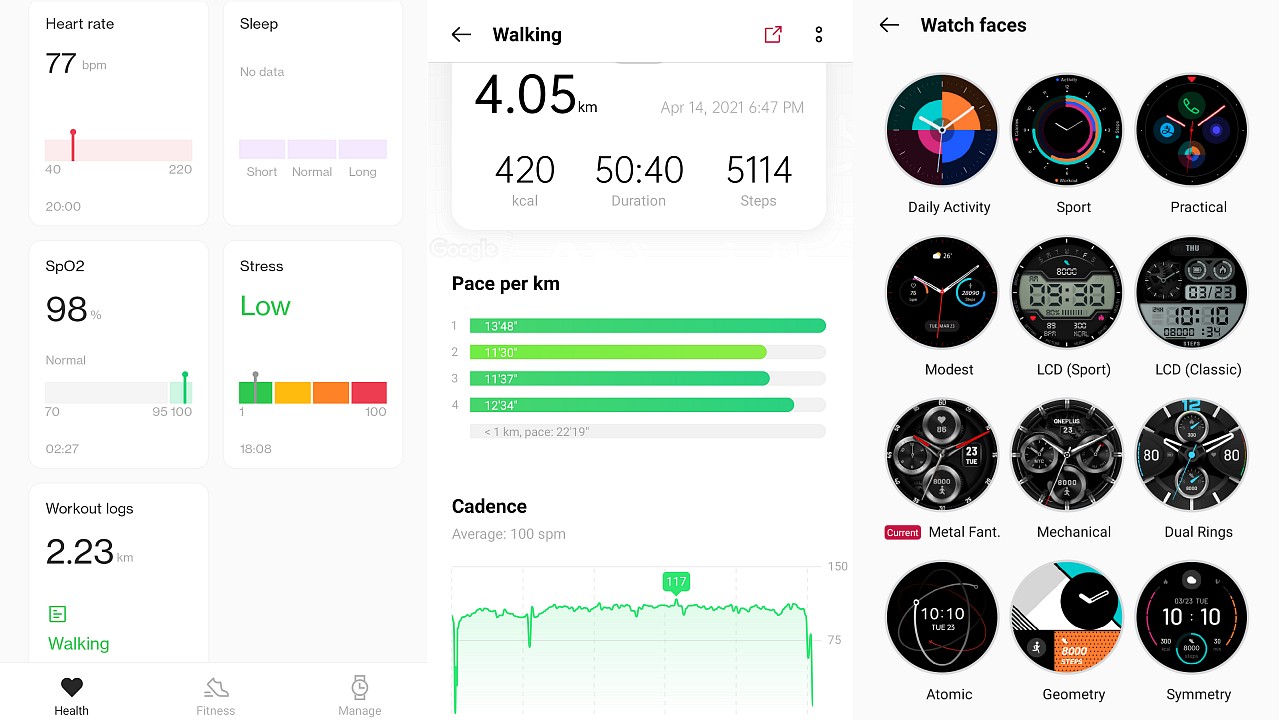
OnePlus Health app. Image: Tech2/Ameya Dalvi
Before you start using this fitness watch, you need to install the OnePlus Health app on your Android phone (not available on iOS yet) and sync it over Bluetooth. The process is fairly smooth, but the app still has very limited features. It displays basic fitness data, and certain watch settings are either hidden deeper than necessary or scattered across different tabs. As I touched upon in the earlier point, options to tweak UI elements on the watch other than watch-faces are non-existent. I would have preferred some control over what I want the watch to display on different screens when I swipe left on the watch, rather than the predetermined options. Perhaps in some future update.
Price and verdict
The OnePlus Watch sells for Rs 14,999 with a one year warranty. For that price, it offers a good design, solid build, excellent display, a nice bunch of features, good battery life and generally reliable fitness tracking. Phone call functionality and the option to sync fitness data with Google Fit are rare features in this segment. A handful of issues such as notification management, indoor step counter, sedentary reminders etc still need a fix, and the companion app certainly needs an upgrade. But, given how much the product has improved over the past month since I started using it, there is hope that it will improve further.
The OnePlus Watch is a pretty decent product as long as it covers your fitness needs. Do make sure that your preferred workouts are tracked. However, given its slightly higher price tag, it may not fly off the shelves easily. The competition is quite stiff. You get the Realme Watch S Pro with a similar feature set ‒ barring a couple ‒ that sells for a good Rs 5,000 lower than the OnePlus. Xiaomi’s Mi Watch Revolve (Review) ‒ again with similar features ‒ also sells under 10K and has a better companion app. And last but not the least, the Amazfit duo of GTR 2e and GTR 2 priced at Rs 9,999 and Rs 12,999 respectively, with better tracking and an even better battery life may pose a serious threat to the OnePlus Watch. Pick one that best suits your needs.

